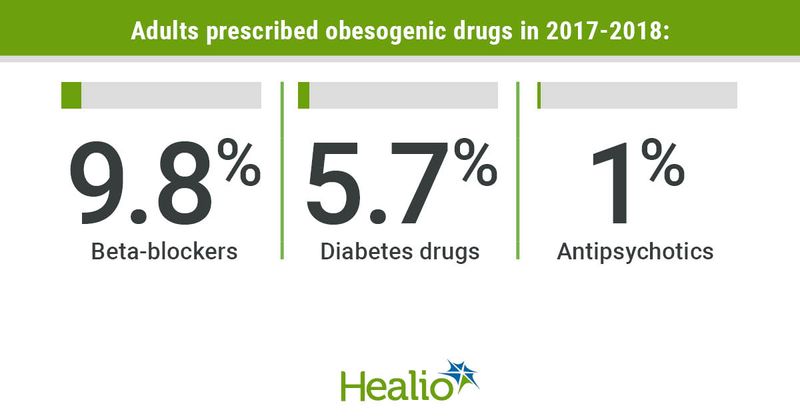20% of adults use medications that cause weight gain
One in five adults in the National Health and Nutrition Examination Survey 2017-2018 reported prescriptions for obesogenic medications, according to results published in Obesity.

“The prevalence of obesity among adults in the U.S. has been increasing for decades. Using certain prescription medications can lead to weight gain and can hinder weight-loss efforts,” Craig M. Hales, MD, MPH, MS, a medical epidemiologist with the National Center for Health Statistics at the CDC, told Healio. “However, it was unknown how commonly adults use these medications. We set out to evaluate trends in the use of obesogenic prescription medications among U.S. adults from 1999 to 2018, both overall and by therapeutic class. We also wanted to see if there is a relationship between obesity and use of obesogenic prescription medications for each therapeutic class.”

Researchers assessed cross-sectional data of 52,340 adults aged 20 years and older from the 1999 to 2018 NHANES. Obesogenic medications were defined according to the 2015 Endocrine Society guidelines, and weight status was categorized by BMI as normal weight (BMI < 25 kg/m2; n = 2,792), overweight (BMI 25-29.9 kg/m2; n = 3,357), class 1 and 2 obesity (BMI 30-39.9 kg/m2; n = 3,402) and class 3 obesity (BMI > 40 kg/m2; n = 893).
In the NHANES 2017-2018, 20.3% of adults reported using at least one obesogenic medication, which was a significant increase from the 13.2% observed in 1999-2000. The most common obesogenic medications were beta-blockers and diabetes drugs, with 9.8% and 5.7% of participants reporting their use, respectively. Conversely, antipsychotics were the least commonly prescribed obesogenic medications with only 1% of patients.
Researchers observed glucose metabolism, hypertension, neuralgia or neuritis, heart disease and musculoskeletal pain and/or inflammation as the most common reasons for obesogenic medication prescriptions.
Researchers observed an increase in the proportional use of obesogenic medications from 34.4% in 1999 to 55% in 2018 for anticonvulsants. However, there was a decrease in antidepressants (32.1% vs. 18.8%), diabetes drugs (82.9% vs. 52.5%) and beta-blockers (83.9% vs. 80.7%) during the same period.
Obesogenic medication proportional use was not associated with weight status in patients, except for antipsychotic medications., according to the researchers.
“The most important limitation of this study is that there is no consensus list of obesogenic medications,” Hales said. “Different systematic reviews of obesogenic medications have led to variations in which medications are identified as obesogenic.”
For more information:
Craig M. Hales, MD, MPH, MS, can be reached at ewx2@cdc.gov.
